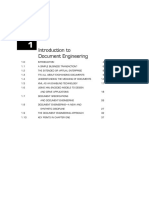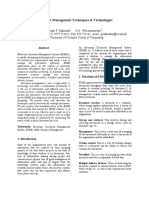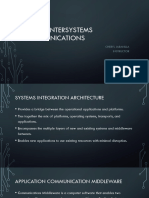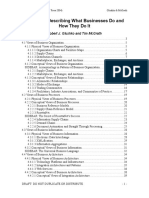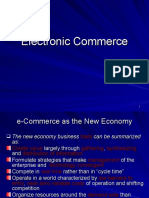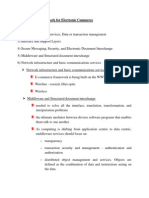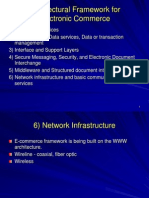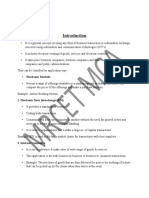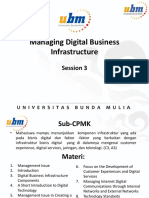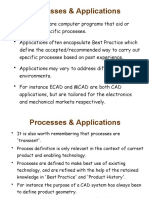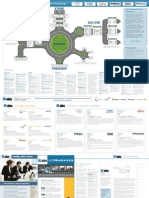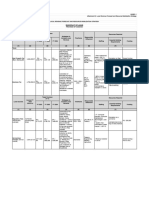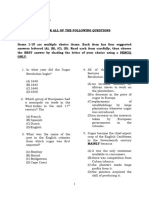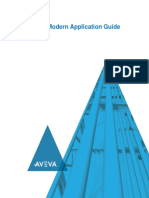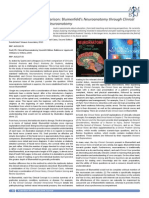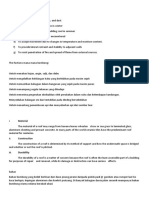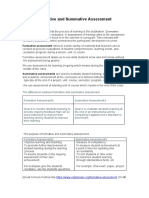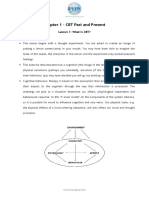E COMMERCE
Unit-IV
THE CORPORATE DIGITAL LIBRARY
DIMENSIONS OF THE INTERNAL ELECTRONIC COMMERCE SYSTEM
MARKETING A BUSINESS CASE FOR DOCUMENT LIBRARY TYPES
OF DIGITAL DOCUMENTS
ISSUES BEHIND DOCUMENT INFRASTRUCTURE
CORPORATE DATA WAREHOUSES
DIMENSIONS OF THE INTERNAL ELECTRONIC COMMERCE SYSTEM
These are the following dimensions for internal electronic commerce organization:
User modeling and interaction:
User models are interposing between the user interface and information sources to filter
the available information according to the needs of the task and user.
It associates with each task or each person is a user agent or set of user agents.
Tasks of user agents are:
- Maintaining of model & current state of the task
- Determining of information for each step of the task
- Appropriate combining of information with user.
Addressing the issue of displaying information to the user.
Considering of wide range of display devices.
Determining the most appropriate methods for display.
In this user agent tackle two issues:
1. Generation of documents
2. Presentation of documents.
Effective utilization of information
Organization decision making cannot be supported with a single tool, a set technology
tools are required for effective utilization of information.
Organization needs online –transactions for design, production, logistics and profitability.
Page 59
�E COMMERCE
Types of On-line transaction:
Two types of on-line transaction are :
1. On-line transaction processing (OLTP).
2. On-line analytical processing (OLAP).
OLTP involves the detailed, day-to-day procedures such as order entry & order
management.
OLAP refers to the activity involved in searching the wealth of data residing throughout
an enterprise for trends, opportunities.
Navigating the info sphere
It involves two elated activities:
- Information search, discovery and retrieval.
- Presentation of retrieved Information.
Search, Discovery and Retrieval:
This view is changing in three ways.
1. Characterization of accessible information
2. Search concepts from this information.
3. Development of information filter
Presentation or visualization:
It is used for easy understanding of information.
Organization must predefine rules for visualization.
This process will highlight the trouble spots and area of opportunities.
Presentation increases the fallowing tasks of information :
1. Accessing ability of information.
2. Collecting of information.
3. Queue of information.
4. Organizing of information.
Page 60
�E COMMERCE
Digital Library Layer
Many organizations manage their information through corporate library, if it provide the
architecture to model, map, integrate & information in digital documents is called digital
library.
It provides information structures by this organizations &workers access vast amount of
data encoded in multimedia formats.
Digital libraries are of two types:
1. Electronic document-based digital libraries.
2. Data-base oriented warehouses.
Document digital library:
The term document is used to denote all non data records I.e. books, reports, e-files,
videos and audios.
Digital library is simply a distributed network of interlinked information.
Data warehouses:
It is a central repository for combining and storing vast amount of data from diff sources.
Sources are main frame database, lint-server database, text reports….etc.
MAKING A BUSINESS CASE FOR DOCUMENT LIBRARY
This section highlights the role that documents play in today’s organization and how
business can better meet their customers’ needs by improving document management
support.
Logical cases
& contracts
Customers Govern
&stake- ment
holders regulations
R&D
engineerin
Sales &
Corporat g
marketing
e
digital library Human
resource
Service
s
and
supports
Manufacturin
Documentation, g and
manuals, production
records Accountin
g and
finance
E-COMMERCE 14
Page 61
�E COMMERCE
Digital Document Management Issues and Concerns
Ad hoc documents: Letters, finance reports, manuals are called ad hoc documents,
which are prepared by managers &professionals.
Process-specific documents: invoices and purchase orders which are created,
constructed and distributed by support personnel. these are form based.
Knowledge-oriented documents: these are technical documents, catalogs of product
information, and design documents.
Types of Digital Documents
Four types of digital documents are:
Structuring applications around a document interface
Structuring interlinked textual & multimedia Documents.
Structuring and encoding information using document-encoding standards
Scanning documents for storage and faxing.
Document Imaging
Document imaging emulates microfiche and microfilm.
An imaging system passes appear document through a scanner that renders it digital and
then stores the digital data as a bit-mapped image of document.
The problem with the imaging approach is that the output contains only images not text.
The following imaging standards are prominently used:
TIFF (tag image file format): format for interchange of bit-mapped images.
ITU-TSS (international telecommunication union-telecommunication standardization
sector) Group IV T.6 facsimile: this standard is used for compression and exchange of
bit-mapped files.
Structured Documents
A structured document provides clear description of document content.
Structured documents apply data-base structuring capabilities to individual documents
and document collections.
Standard for structured documents are:
SGML (Standard Generalization Markup Language):
Page 62
�E COMMERCE
It is an ISO standard for interchange & multi formatting description of text document in
terms of logical structure.
ODA (Office Document Architecture):
It is an ANSI & ISO standard for interchange of compound office documents.ODA
specifies both content & format.
CDA (Compound Document Architecture):
It defines set of rules for content and format .It defines services for compound
documents.
RTF (Rich –Text Format):
It is developed by Microsoft for interchanging of desk top documents.
Hyper Text Documents
Hyper text is a way of making document-based information more mobile.
Reasons for mobility of information are:
Information in enterprises is seldom located on server but is distributed throughout the
organization.
Accessing & retrieving large monolithic document is time consuming.
Reuse of document for composing new documents is difficult task.
In this relationships between documents can be represented through hypermedia links i.e.
hyperlinks.
Standards of Hypermedia:
HyTime: it adds time based relationships like synchronization, it is extension of SGML.
HTML: developed by WWW to support distributed hypermedia.
MHEG(multimedia /hypermedia encoding/exporting Group):standard for presenting
objects in multimedia
Active documents
Active document represents what is known as document oriented computing.
Active document provide an interactive interface between documents.
Active documents are especially powerful because they combine composition of
information with the distributed nature of information.
Ex: spreadsheet, word-processing..etc
Page 63
�E COMMERCE
Issues behind Document Infrastructure
Document infrastructure addressed these questions:
What is the proper architecture for the corporate digital library?
What are appropriate model?
What protocols required?
What are the best human interfaces?
How does one represent and manipulate the information processing activities occurred in
the digital library?
Document Constituencies:
The emerging document processing & management strategies must address these
constituencies.
They need system to access distributed repositories& to manipulate them in a number of
ways.
Document-oriented processes
Components of Document-oriented processes are:
Document creation
Document media conversation(it accept multiple forms of input)
Document production and distribution
Document storage and retrieval
Document-based framework flows:
The following Four activities make up the document-based framework flow:
Document modeling: it defines the structure and processes the document.
Transformation: creates modules for capturing and validating.
Synthesizing: create value-added information from the combination of two or more
documents.
Business modeling: defines the structure and processes of the business environment.
Page 64
�E COMMERCE
Corporate Data Warehouses
Architecture of the data warehouse is as fallows :
Data migration Corporate Data replicated
from data from
operational operational
warehouse
database database
Query
monitors
search and
clients retrieval clients
Middleware
for data
access
E-COMMERCE 27
Data warehouse is used store information of the organization.
Data warehouse is needed as enterprise wide to increase data in volume and complexity.
Characteristics of data warehouse are:
An information-based approach to decision making.
Involvement in highly competitive & rapidly changing markets.
Data stored in many systems and represented differently.
Functions performed by data warehouse are:
Allow existing transactions and legacy systems to continue in operation.
Consolidates data from various transaction systems into a coherent set.
Allows analysis of virtual information about current operations of decision support.
Types of data warehouses
There are four types of data warehouses:
Physical data warehouse: It gathers corporate data along with the schemas and the processing
logics.
Logical data warehouse: It contains all the Meta data and business rules.
Data library: This is sub set of the enterprise wide data warehouse.
Decision support system (DSS): These are the applications but make use of data warehouse
Page 65
�E COMMERCE
Managing data
To manage data fallowing steps are needed:
Translation
Summarizing
Packaging
Distributing
Garbage collection
Advantages of data warehouse:
Timely and accurate information become an integral part of the decision-making process.
User can manage and access large volumes of in one cohesive framework.
Data warehousing has wide spread applicability.
It provides point-of-sales reports instead of end-of –day reports.
Advertising and Marketing on the Internet
The new age of information-based marketing.
Advertising on the internet.
Marketing research.
The New Age of Information-Based Marketing
The new age of information-based marketing differentiate interactive marketing into four
areas:
Retailers vs manufacturers
Target and micromarketing
Small business vs large business
Regulatory and legal implications of cyberspace marketing.
Retailers’ vs Manufacturers:
The role of Retailers and manufacturers are fast reversing in electronic commerce.
Retailer’s vs Manufacturers have the fallowing methods:
Market research and customer prospecting.
Page 66
�E COMMERCE
Market presence method
Product or services building method
Information-based products pricing and priority method.
Target and Micromarketing:
Electronic commerce, technology has put target and micromarketing within the research
of small business.
It gives information to the micro marketers not only about its own business but also
consumer’s information.
Consumer target is two-way flow of communication between seller and buyer.
Direct mail and telemarketing are two fast growing ways to micro market.
Technology is an essential tool in micromarketing.
There are two main types of micromarketing:
Direct-relationship micromarketing: is aimed at stimulating sales at retail establishments
through direct contacts with consumers.
Direct-order micromarketing: is focused on selling products directly to consumers in their
homes or businesses.
Small vs large: Thread avoid vs goliath syndrome
The key distinction between small and large business remains access to national and
international marketing for advertising purposes.
Today, exorbitant advertising cost represents the barrier to reaching the customer
effectively. Internet and other networks plays good role in advertising.
The major difference between the internet and other I-way advertising media are
ownership and membership fees.
Due to the empowering effect of internet-facilitated advertising however, the balance of
power between large and small companies may change in future.
Advertising on the Internet
The notion of advertising and marketing became inevitable after 1991 when the internet
was opened for commercial traffic.
There are very good reasons for embracing the inevitability of growing of commercial
advertising on the internet:
- Advertising conveys much needed information
Page 67
�E COMMERCE
- Advertising generates significant revenue
Key components for making internet advertising effectively are:
Advertising process
Core content
Supporting content
Market and consumer research
Repeat customers
On-line advertising paradigms:
Two different advertising paradigms are emerging in the on-line world, they are:
1. Active or push-based advertising
2. Passive or pull-based advertising
Active or push-based advertising:
Active or push-based advertising is of two types they are :
The broadcast model:
Broadcasting message provides a means for reaching a great number of people in short
period of time.
It mimics the traditional model, in which customer id exposed to the advertisement
during TV programming.
It basically uses direct mail, spot television, cable television.
Text-based broadcast messages also used in advertising in Usenet news groups.
The junk mail model:
Disadvantage of the direct mail include relatively high cost per contact.
Junk mail is the just poorly targeted direct mail.
It is most intrusive of all forms of internet advertising, because it is easily implemented
using electronic mail.
Junk mail creates unwanted expense as well as an annoyance.
Passive or pull-based advertising
Pull-based advertising provide a feedback loop, company and customers.
Page 68
�E COMMERCE
On-line pull-based advertising includes the following:
Billboards
Catalogs or yellow pages directories:
endorsements
Based on the above three we have the fallowing models:
The billboards or www model:
Billboard advertising is often used to remind the customer of the advertising messages
communicated through other media.
The advantage of this model is no customer charges.
In this message must be simple, direct.
Catalog and yellow pages directory model:
Traditionally, the most visible directory service of advertising is the yellow pages.
Catalog model is the least intrusive model but requires active search on the part of
customer.
Yellow pages are low in cost in terms of production and placement.
Disadvantage of yellow page include lack of timeliness and little creative flexibility.
Customer endorsement model:
In endorsements people tell their experiences with products and services.
These are in question and answer format.
Marketing Research
Market research is extremely important for companies in terms of how they allocate their
advertising dollars in sales promotions, how they introduce new products, how they target
new markets.
Broadly marketing research is divided into three faces:
Data collection
Data organization
Data analysis and sense making
Data collection:
Markets mainly relied on source database for understanding consumer behavior.
Page 69
�E COMMERCE
Source data base mainly comprise of numeric information.
Delivery of source database services fallows two main patterns.
Data collect and collate data, making it available by data base producers.
Data collect and collate data, making it available by central hosts like CompuServe,
American online..etc.
Data organization:
Everyone is collecting data from electronic commerce, but very few are organizing it
effectively for developing a marketing strategy.
The key abilities in their environment are:
Leverage its established database into customized offerings by audience and markets.
Leverage its established database in terms of horizontal growth.
Data analysis and sense making:
The ability to link database to analytic tools like econometric programs and forecasting
models is called data analysis.
Market research is undergoing major changes; the next generation of source database will
definitely include multimedia information.
Page 70









